
Ploug House is a listed Neoclassical property on the corner of Højbro Plads and Ved Stranden in central Copenhagen, Denmark. It dates from the building boom which followed after the Copenhagen Fire of 1795 but takes its name from the poet, publisher and politician Carl Ploug who lived there in the 1860s and 1870s and also published the newspaper Fædrelandet from the premises.

The Schottmann House Danish: is a historic property located at Strandgade 10 in the Christianshavn neighbourhood of Copenhagen, Denmark.
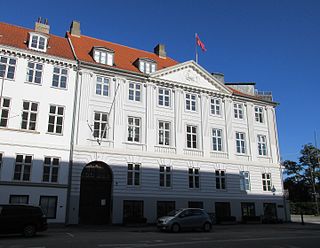
Amaliegade 40, formerly known as Toldbodbørsen, is a Neoclassical property located at the corner of Amaliegade and Esplanaden in the Frederiksstaden district of Copenhagen, Denmark. The shipping company D/S Norden was based in the building for more than one hundred years. It was listed in the Danish registry of protected buildings and places in 1918.
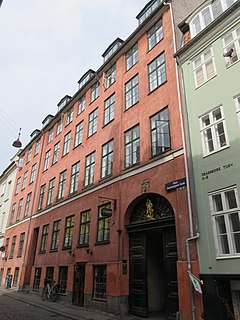
Niels Hemmingsens Gade 32 is a historic building in the Old Town of Copenhagen, Denmark. It was built in the first half of the 1740s. A brewery was for more than one hundred years operated in a rear wing. Brødrene Cloëtta, one of Denmark's leading chocolate manufacturers of irs day, was based in the building from 1865 until 1901. The three-winged building complex was listed on the Danish registry of protected buildings and places in 1981. A gilded Neptune figure is seen above the gateway and the keystone features the names of the first owners. Notable former residents include the naval officers Poul de Løvenørn and Peter Nicolay Skibsted, the businessman Conrad Hauser and the linguist Rasmus Rask.
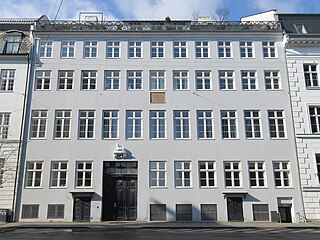
Kvæsthusgade 5 is a historic property in Kvæsthusgade, a short street between the Nyhavn canal and Sankt Annæ Plads, in central Copenhagen, Denmark. The building is listed in ht Danish registry of protected buildings and places. Notable former residents include the military officer Christian de Meza, composer Niels Gade. painter Anna Petersen and art historian Troels Troels-Lund.

Gammel Strand 36 is a Neoclassical property overlooking Slotsholmen Canal in the Olt Town of Copenhagen, Denmark. The building was listed in the Danish registry of protected buildings and places in 1945. Notable former residents include the composer Franz Joseph Glæser.

Højbro Plads 15 is a Neoclassical property situated on Højbro Plads in central Copenhagen, Denmark. The building was like most of the other buildings in the area constructed as part of the rebuilding of the city following the Copenhagen Fire of 1795. It was listed in the Danish registry of protected buildings and places in 1950.
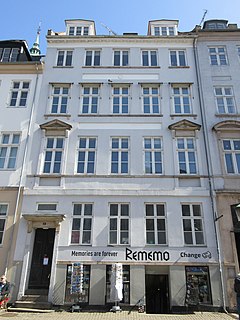
Højbro Plads 17 is a Neoclassical property situated on the east side of Højbro Plads in central Copenhagen, Denmark. The building was like most of the other buildings in the area constructed as part of the rebuilding of the city following the Copenhagen Fire of 1795. It was listed in the Danish registry of protected buildings and places in 1924.
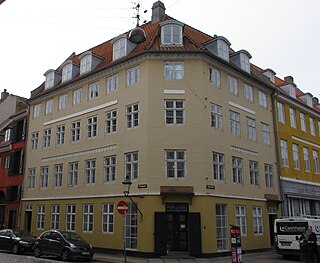
Nikolakplads 23 is a Neoclassical property situated at the corner of Nikolaj Plads and the street Nikolajgade in central Copenhagen, Denmark. It was listed in the Danish registry of protected buildings and places. The building was listed in the Danish registry of protected buildings and places in 1934. Former residents include scientific illustrator Johannes Eilert Steenfeldt, composer Rudolph Bay and playwright and theatre historian Thomas Overskou. The building is owned today by Karberghus.

Vingårdstrøde 19 is a Neoclassical property situated on Vingårdstræde, between Kongens Nytorv and Nikolaj Plads, in central Copenhagen, Denmark. Like most of the other buildings in the area, the building was constructed as part of the rebuilding of the city following the Copenhagen Fire of 1795. It was listed in the Danish registry of protected buildings and places in 1959. A number of people associated with the Royal Danish Theatre have resided in the building, including ballet dancers and choreographers Antoine Bournonville, August Bournonville and Carl Dahlén, as well as a number of members of the Royal Danish Orchestra. Other notable former residents include future cookbook writer Anne Marie Mangor, portrait painter Johan Frederik Møller and sculptor Daniel Peter Støhrmann.

Toldbodgade 5 is a 17th-century property situated in Toldbodgade, off Nyhavn in central Copenhagen, Denmark. It was listed in the Danish registry of protected buildings and places in 1977. The composer Carl Nielsen and the sculptor Anne Marie Carl-Nielsen resided in the apartment on the first floor from 1898 to 1906.
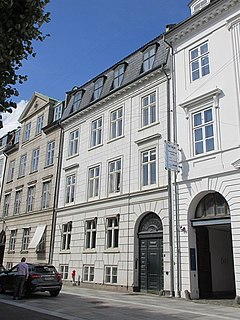
Sankt Annæ Plads 9 is a mid 18th-century property situated on the north side of Sankt Annæ Plads, opposite the Garrison Church, in the periphery of the Frederiksstaden district of central Copenhagen, Denmark. Constructed in 1750 according to designs by Nicolai Eigtved, then with apartments for members of the upper middle-class, it was from around 1810 until 1839 used as the last home of Garnisons Workhouse and Girls' School. In 1840, it was again adapted for use as a high-end apartment building by Thomas Blom. The building was listed in the Danish registry of protected buildings and places in 1932. Notable former residents include the composer Johan Christian Gebauer, lawyer and politician Christian Albrecht Bluhme, professor of medicine C.E. Fenger and the former politician and swindler Peter Adler Alberti.

Amagertorv 1 is a Neoclassical property situated at the corner of Amagertorv and Højbro Plads, opposite Højbrohus, in the Old Town of Copenhagen, Denmark. Constructed in 1797 as part of the rebuilding of the city following the Copenhagen Fire of 1795, it owes its current appearance to a renovation undertaken by Christian Tybjerg in 1854. The building was listed in the Danish registry of protected buildings and places in 1989. Café Europa, a café started by fashion designer Jørgen Nørgaard in 1989, is located in the building. Notable former residents include photographer Emil Stæhr, landowner and district governor Nicolai Emanuel de Thygeson and composer and music publisher Andreas Peter Berggreen.

Nyhavn 47 is an 18th-century property situated at the corner of Nyhavn and Toldbodgade in central Copenhagen, Denmark. It owes its current appearance to a renovation undertaken by Julius Andreas Blom in 1842–45. It was listed in the Danish registry of protected buildings and places in 1932. Notable former residents include the merchant and shipowner Peter Christian Knudtzon.
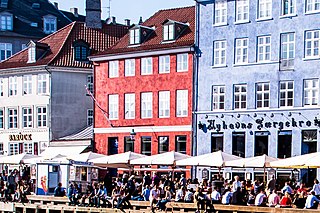
Nyhavn 3 is an 18th-century property overlooking the Nyhavn Canal in cental Copenhagen, Denmark. It was listed in the Danish registry of protected buildings and places in 1945.

The Sigvert Grubbe House is a Renaissance style townhouse situated at Strandgade 28 in the Chrstianshavn neighborhood of central Copenhagen, Denmark. The property comprises the building at Wildersgade 41 on the other side of the block as well as a half-timbered building separating two central courtyards from each other. The apartment on the first floor features a number of murals attributed to Nicolai Abildgaard. The entire complex was listed in the Danish registry of protected buildings and places in 1918. It takes its name after its first owner, Sigbert Grubbe, a favourite of ChristianIV. It was later owned by Jacob Benjamin Italiaender, a Sphardi Jew, who established a tobacco manufactory as well as a private sunagogue in the yard. The painter Peder Severin Krøyer grew up in the building in the 1860s.

Krigsråd Mørks Minde, situated at Lille Kannikestræde 4, is a charity with affordable accommodation for widows and unmarried women from the higher classes in Copenhagen, Denmark, established by Emilie Henriette Mørk (Mørch) in 1864–65 in memory of her father, Claudius Mørch, who was awarded the title of krigsråd. The Neoclassical building was constructed by master mason Christian Aagaard in 1830–31. It was listed in the Danish registry of protected buildings and places in 1950. Notable former residents include actor Ludvig Phister, cookbook writer Anne Marie Mangor, painter Emil Carlsen and Professor Nicolai Christopher Kall Rasmussen.

Store Kannikestræde 15 is a Neoclassical property situated at the corner of Store Kannikestræde and Lille Kannikestræde in the Old Town of Copenhagen, Denmark. It was listed in the Danish registry of protected buildings and places in 1950. A plaque on the facade commemorates the fact that Peter Faber was a resident in the building when he wrote Højt fra træets grønne top in 1847. Other notable former residents include the landscape painter Thorald Læsøe, printmaker Søren Henrik Petersen (1788-1860), historian Caspar Frederik Wegener and illustrator Peter Christian Klæstrup.

Hauser Plads 12 is a Neoclassical property situated on the south side of Hauser Plads in the Old Town of Copenhagen, Denmark. It was listed in the Danish registry of protected buildings and places in 1945. Notable former residents include the actor Jørgen Christian Hansen and the film director Carl Theodor Dreyer.

Hauser Plads 24/Pbenrå 23 is an 18th-century building complex occupying an irregular corner site between the square Hauser Plads and the street Åbenrå, north of a short unnamed street section linking the square with the street, in the Old Town of Copenhagen, Denmark. It is the only building on the square that dates from the time before the British bombardment in 1807 and the subsequent creation of the square. It was listed in the Danish registry of protected buildings and places in 1945. Niels Frommelt operated an underground printing workshop in the building during the German occupation of Denmark in World War II.



























